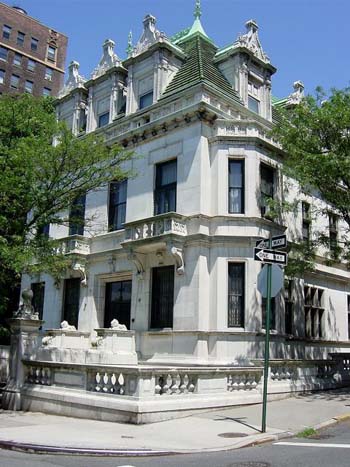 |
New York
Architecture Images-Upper West Side The Schinasi Mansion |
|
architect |
William Tuthill |
|
location |
351 Riverside Drive at 107th St. |
|
date |
1909 |
|
style |
French Renaissance |
|
construction |
Vermont Marble |
|
type |
House |
|
|
|
|
images |
 |
|
|
|
|
notes |
The
Schinasi Mansion The Schinasi mansion was built in 1909 by Morris Schinasi, an immigrant from Turkey who made his fortune introducing Turkish tobacco to the United States. Its architect is William Tuthill, who also designed Carnegie Hall. For a brief period starting in the 1880's, it was expected that Riverside Drive would rival Fifth Avenue as a location for the homes of the very rich, though this fashion didn't last. It is built in a French Renaissance style out of Vermont Marble. Its lavish interior, which includes a dome lacquered in gold, rejects the vulgar eclecticism of most "robber baron" mansions of its period, and is consistently Renaissance in style. It currently belongs to Hans Smit, a Columbia Law School professor who owns several other historic houses around the world. It used to have a tunnel down to the Hudson River for bringing in tobacco, though this has been sealed up. |
|
Schinasi: A Manor from Turkish Tobacco By Christopher Gray [Based on material in Christopher Gray's New York Times May 4,1997 article] In the 1880s, the predictions for the future of Riverside Drive were bright. All the rich people with mansions on congested Fifth Avenue would surely soon move over to the picturesque Hudson River, where they could build graceful, freestanding houses surrounded by light, air and grass. But by the early 1900s most of the rich folks had decided that they liked Fifth Avenue, even if it was crowded with sightseers and its mansions had less breathing space than tenements But not everyone agreed with the prevailing wisdom. The Pennsylvania steel millionaire Charles Schwab finished his fullblock house from 73 to 74 St. in 1906, and in 1907 Morris Schinasi began what is now the most impressive house in private ownership on Riverside Drive. Schinasi had emigrated from Turkey in the 1890s with his brother Solomon. They brought Turkish cigarettes with them and popularized the much stronger tobacco here, building and cornering the market within a few years. For his new house, Morris Schinasi retained William Tuthill, the architect for Carnegie Hall. The French Renaissance style, Vermont white marble mansion that Tuthill designed for Schinasi was called by the Real Estate Record & Guide "a four-sided house, and exquisite from any side." The white marble blocks placed in construction in accordance with their veining are set off by a bright green tile roof with fanciful copper cresting. To mitigate against what the journal called the "incorrigible vandal" of New York's polluted air, Schinasi had water taps distributed around the outside of the house to permit frequent washing. Surrounded by plantings and set back from the property line on all sides, the design of the three-story house reproached the tall, densely built mansions going up on the East Side. Although a few private houses went up on Riverside Drive after 1909, none approached the Schinasi house in scale or design. The building (at 107 St.) was designated a landmark in 1974. The house was sold in 1930 and was first a school and later a daycare center. In 1979, Hans Smit, a law professor at Columbia University, bought the building, and has been working on the restoration for almost two decades. In an interview last month,he said he was now "just a couple of inside doors" short of a complete interior restoration. The new exterior iron doors are among the final touches on the exterior restoration. The outside is presentable, but not pristine. "If I really fix up the outside, the undesirable elements will pay attention" Smit says. "When I bought it, most people said, 'You're a raving maniac.' But it's the best investment I ever made." |
|
|
links |